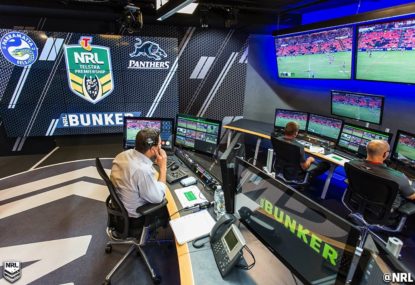If someone were to open up my iPhone and look at my most frequently used emojis you would see the following: a face crying with laughter, a Queen, an upside down smiley, a face with love hearts for eyes, a footy and a woman shrugging her shoulders saying ‘I don’t know’.
In my life there are plenty of circumstances where I don’t know the answer to a question or how to respond in a certain situation – whether it be because of a lack of knowledge, a lack of information or because of my indecisiveness.
In these situations, I often become a real life emoji. I shrug my shoulders and say ‘I don’t know’.
The opportunity to shrug their shoulders and say ‘I don’t know’ is not one that is afforded to referees in the NRL.
Despite the availability of technology, additional pairs of eyes and the multitude of camera angles available to the NRL officiating team in the Bunker, referees in the NRL are put in a position where they are forced to make a decision at all times (particularly when it comes to ruling on a try).
I was reminded of this during the game between the Cronulla Sharks and the Penrith Panthers on Easter Sunday.
In the 60th minute of this game the Sharks were on the attack after getting possession through an intercept by Ricky Leutele. In the minute following this intercept, Andrew Fifita charged towards the Sharks try line, but fell just short.
In the very next play, Paul Gallen tried the same thing and charged toward a very tired Panthers defensive line. Gallen broke through the line and carried Peter Wallace and Matt Moylan over the line with him and appeared to ground the ball.
Or did he?
Gallen looked up towards on-field referee Gerard Sutton. Sutton indicated that his on-field decision was try and it was sent upstairs to the Bunker for this to be confirmed.
To be clear, the rule in this circumstance is that the on-field referee must make a decision of try or no try. If the ruling is try, then the Bunker must find sufficient evidence that a try has not been scored to overturn the decision. If the ruling is no try, then the Bunker must find sufficient evidence that the on-field decision should be overturned.
After watching the replay several times, despite the on-field decision being try the footage was extremely unclear.
When I watched the replay, I could not see any evidence of Paul Gallen grounding the ball. What I saw was a very committed defensive display from Peter Wallace and the ball initially being held up in the air on top of Gallen’s arm. Even after Gallen wriggled around and tried to ground the ball, it looked to me like Peter Wallace’s arm had acted as a barrier between the ball and the grass.
Had I been in charge of making a decision after seeing this footage I would have said no try.
Unfortunately, however, because the on-field decision had been try and the Bunker was unable to find sufficient evidence to overrule this decision, the on-field decision stood and the try was awarded.
To be fair to the Panthers, the game was already out of their reach by this point.
The Panthers went into the sheds trailing 12-2 at half time. Penrith’s performance up until this point was characterised by one-dimensional attack and silly errors. Frustration slowly started to creep in as more and more passes found the turf instead of the intended player.
Despite putting the Sharks under immense pressure in the early stages of the first half with the Panthers having plenty of possession in their own 20-metre zone, they simply could not break the Sharks line.
In a bitter blow for Penrith fans, despite having most of the possession in the opening exchanges, the moment the Sharks made their way down-field, they managed to score points – first through James Maloney and then later through Sosaia Feki.
The Sharks went on to win this game comfortably, by 28-2 but just because this decision did not have much of an impact on the final result, does not mean that we should not strive to give the on-field referee’s every opportunity to make the correct decision.
This year, I have noticed the on-field referee’s being bolder. More tries are being decided on the spot and there is far less reliance on the Bunker. As a fan I appreciate this – it keeps the game flowing and demonstrates that the on-field referee is firmly in control of the game. I also respect a referee that has the confidence to back themselves and to make a decision.
However, there are some circumstances where it’s clear that the on-field referee cannot make a call, either because they were not in position or could not get close enough to the play.
In this circumstance (which should be rare), I would like to see the on-field referee have the opportunity to refer this decision to the Bunker. The Bunker has the benefit of many angles and the opportunity to slow down the play and make an effective decision. We should absolutely utilise this technology when appropriate.
Had Gerard Sutton had this opportunity on Sunday, I have the feeling that a different decision would have been made and that Paul Gallen would not have been awarded a try.
Despite wanting our referees to be indecisive, I would like to see them being given the opportunity to shrug their shoulders and say ‘I don’t know’. This is not a sign of weakness or poor refereeing – it’s a sign of humanity.
We have a Bunker – let’s use it to its full potential.





























































































